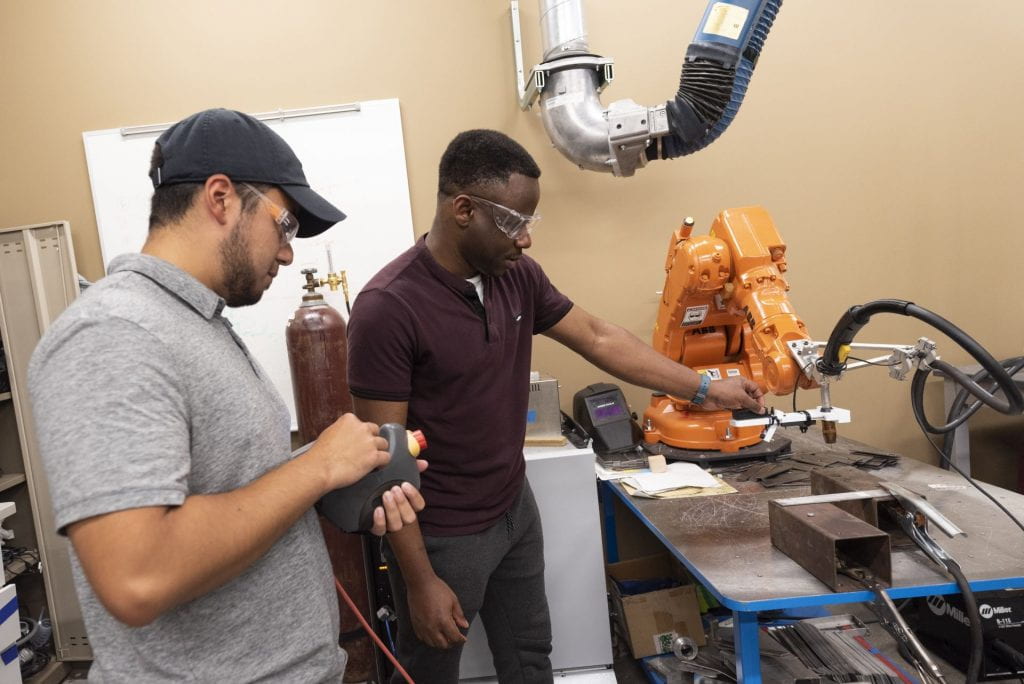
Recent advancements in sensing and information technologies enable us to collect a lot of data during manufacturing processes. However, the data are hardly used to improve the performance of these manufacturing processes. This is because the manufacturing environment is constantly changing and there are many disturbances to the manufacturing processes which make the data difficult to use. The complex robotic assembly process for torque converter assembly [1, 2] is a typical example in automotive manufacturing. The parts to be processed could come from different batches and sometimes different suppliers. All of these variations will cause difficulty for conventional industrial robots to perform this kind of manufacturing processes [3-8]. Installing the converter into the transmission is not always as easy as it looks. The converter has to be aligned correctly, rotated back and forth and hopped up and down repeatedly to allow the splines and hub tabs to engage the transmission correctly. Many parameters are involved such as rotation speed and angle, hopping speed and amplitude and insertion force for each stage. The assembly process will fail if these parameters are not tuned correctly. Normally, the performance of the robotic assembly is measured by the assembly cycle time and First Time Through (FTT) rate [1-8] . The FTT rate of the assembly process can be decreased from 98% to about 60% or less because of the variations. Because manufacturing processes are typically very complex, it is hardly possible to construct a physical model using first principles to optimize the process parameters. Hence, a parameter optimization method without using any physical model has to be investigated in order to optimize the assembly performance. Therefore, the objectives of this project are (1) Modeling of complex manufacturing processes; (2) Parameter optimization. Gaussian Process Regression (GPR) is a non-parametric tool that can easily handle modeling problem with noisy observations and system uncertainties [9-10]. The GPR surrogated Bayesian Optimization Algorithm (GPRBOA) [11-17] has been implemented in several offline applications such as environmental monitoring [18], material design [14, 19] and machine learning [20, 21]. It can iteratively model a complex system and optimize the system performance.
Dr. Chen leads this project.
[1] D. Gravel, A. Bell, B. Zhang, and F. Zhang, Robot Learning and Self Optimization of Process Parameters, 2012.
[2] D. Gravel, F. Maslar, G. Zhang, S. Nidamarthi, H. Chen, and T. Fuhlbrigge, “Toward robotizing powertrain assembly,”2008 7th World Congress on Intelligent Control and Automation, pp. 541-546, 2008.
[3] F. Dietrich, D. Buchholz, F. Wobbe, F. Sowinski, A. Raatz, W. Schumacher, et al., “On contact models for assembly tasks: Experimental investigation beyond the peg-in-hole problem on the example of force-torque maps,” 2010 IEEE/RSJ International Conference on Intelligent Robots and Systems, pp. 2313-2318, 2010.
[4] S.-k. Yun, Compliant manipulation for Peg-in-Hole: Is passive compliance a key to learn contact motion?, 2008.
[5] H. Chen, J. Wang, G. Zhang, T. A. Fuhlbrigge, and S. Kock, “Robotic soft servo for industrial high precision assembly,” 2008 IEEE Conference on Robotics, Automation and Mechatronics, pp. 24-29, 2008.
[6] F. Yanqiong, W. Jianfeng, and Z. Xifang, “Study on Three Dimensional Dual Peg-in-Hole in Robot Automatic Assembly,” ed, 2006.
[7] S. Chhatpar and M. Branicky, Localization for Robotic Assemblies with Position Uncertainty vol. 3, 2003.
[8] J. Wei and W. S. Newman, “Improving robotic assembly performance through autonomous exploration,” Proceedings 2002 IEEE International Conference on Robotics and Automation (Cat. No.02CH37292), vol. 3, pp. 3303-3308 vol.3, 2002.
[9] C. K. I. Williams and C. E. Rasmussen, “Gaussian processes for regression,” presented at the Proceedings of the 8th International Conference on Neural Information Processing Systems, Denver, Colorado, 1995.
[10] C. Rasmussen and C. Williams, “Gaussian processes for machine learning.,(MIT Press: Cambridge, MA),” 2006.
[11] A. Grancharova, J. Kocijan, and T. Johansen, “Explicit stochastic predictive control of combustion plants based on Gaussian process models,” Automatica, vol. 44, pp. 1621-1631, 06/01 2008.
[12] J. Kocijan and R. Murray-Smith, Nonlinear Predictive Control with a Gaussian Process Model, 2003.
[13] A. I. J. Forrester and A. J. Keane, “Recent advances in surrogate-based optimization,” Progress in Aerospace Sciences, vol. 45, pp. 50-79, 2009/01/01/ 2009.
[14] Y. Jin, “Surrogate-assisted evolutionary computation: Recent advances and future challenges,” Swarm and Evolutionary Computation, vol. 1, pp. 61-70, 2011/06/01/ 2011.
[15] N. Srinivas, A. Krause, S. M. Kakade, and M. Seeger, “Gaussian process optimization in the bandit setting: No regret and experimental design,” arXiv preprint arXiv:0912.3995, 2009.
[16] E. Brochu, V. M. Cora, and N. De Freitas, “A tutorial on Bayesian optimization of expensive cost functions, with application to active user modeling and hierarchical reinforcement learning,” arXiv preprint arXiv:1012.2599, 2010.
[17] A. Jalali, J. Azimi, and X. Z. Fern, “Exploration vs Exploitation in Bayesian Optimization,” ArXiv, vol. abs/1204.0047, 2012.
[18] R. Bardenet and B. Kégl, “Surrogating the surrogate: accelerating Gaussian-process-based global optimization with a mixture cross-entropy algorithm,” in 27th International Conference on Machine Learning (ICML 2010), 2010, pp. 55-62.
[19] M. Osborne, R. Garnett, and S. Roberts, “Gaussian processes for global optimization,” 01/01 2009.
[20] R. Marchant and F. Ramos, “Bayesian optimisation for Intelligent Environmental Monitoring,” in 2012 IEEE/RSJ International Conference on Intelligent Robots and Systems, 2012, pp. 2242-2249.
[21] J. Zhou and L.-S. Turng, “Process optimization of injection molding using an adaptive surrogate model with Gaussian process approach,” Polymer Engineering & Science, vol. 47, pp. 684-694, 05/01 2007.